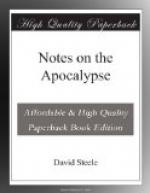be understood metaphorically, not literally; for so
the construction of the Apocalypse requires.
It may import the festering of unmortified corruption
among the votaries of Antichrist, intensified by the
faithful application of the divine law by the witnesses.—The
object of the second vial is the “sea,”
the same as that of the second trumpet, (ch. viii.
8, 9.) The allusion is to Exod. vii. 20, 21. Intestine
commotions, with war, blood and death, seem to be
symbolized. The horns of the beast were often
turned against one another; for the bestial kingdom
was “partly broken.” The toes in
Nebuchadnezzar’s image did not “cleave
one to another.” (Dan. ii. 42, 43.)—The
object of the third vial is the “rivers and
fountains of waters,” (ch. viii. 10; Exodus vii.
19.) These symbols may signify the several kingdoms
of the empire, tributary by their wealth and traffic
to the great city. And as the witnesses continued
to prophesy, giving increased point and publicity to
their testimony, and as the Turks were making encroachments
upon the territories of nominal Christian princes
in the west, extensive wars and great slaughter were
the results. These awful judgments are followed
by the plaudits of two angels. The eternal Jehovah
is recognized as the Author of these judgments.
The Mediator may here be understood, (ch. i. 8;) (John
v. 22, 27.) The “angel of the waters” may
be the same who poured out the vial. He gives
to the Lord the glory of his justice:—“Thou
art righteous.” He also approves the “law
of retaliation:”—“For they
are worthy.” The other angel “out
of the altar” speaks on behalf of the martyrs,
(ch. vi. 9, 10,) recognizing the faithfulness of God:—“True
and righteous are thy judgments.”
8. And the fourth angel poured out his vial upon
the sun; and power was given unto him to scorch men
with fire.
9. And men were scorched with great heat, and
blasphemed the name of God, which hath power over
these plagues; and they repented not to give him glory.
Vs. 8,9.—The object of the fourth vial
is the “sun,” (ch. viii. 12.) “Power
was given him,”—the angel. The
two witnesses are represented as armed with “fire,
which proceedeth out of their mouth, devouring their
enemies,” (ch. xi. 5.) As the formal object of
all the vials is the ecclesiastical, rather than the
civil empire, and the sun is the symbol of the chief
dignitary, perhaps this vial strikes more directly
upon the “man of sin.” The expression
in the introduction to the vials, (ch. xv. 4,)—“thou
only art holy,” seems to be a testimony against
the antichristian “name of blasphemy,”—“His
Holiness.” By the Reformation, symbolized
by successive angels of the fourteenth chapter, those
valiant men tormented the Pope and his vassals, so
that they raged and blasphemed more and more, but
“repented not to give God the glory.”
So it was at the sounding of the sixth trumpet, (ch.
ix. 20, 21.)
10. And the fifth angel poured out his vial upon
the seat of the beast; and his kingdom was full of
darkness; and they gnawed their tongues for pain,




